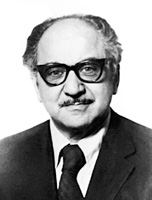Louis N. Levy Z"L
1918 - 1994
"It is mainly due to his lifetime efforts that future generations of Sephardim will be better acquainted with their own identity and heritage."Louis N. Levy was born on the Lower East Side of New York City, on April 23, 1918. His mother, Regina (Calderon) Levy was Monastirli, and his father Nisim Yeuda Levy, was from Chorlu, Turkey. Growing up downtown, he carefully observed the men of his father's generation as they frequented the kavanes (coffee houses), spoke Ladino and read the Judeo-Spanish weekly La Vara. He attended Talmud Tora and synagogue at Berith Shalom - The Sephardic Jewish Center (Centro Judio Sephardi) (at 133 Eldridge Street), and developed close relationships with some of the older generation's leaders there, including Rabbi Joseph de Abraham Benyunes, Albert J. Torres, David N. Barocas, and Rabbi David de Sola Pool of Congregation Shearith Israel - The Spanish and Portuguese Synagogue. Later he went to work with many other 'Turks' in the garment industry and there he met other Community-minded business leaders - Turks, Yanyotis, Saloniklis, and many others. He began to synthesize their values and learned to ignore their differences.
In 1939, he married Rena Dweck, and shortly thereafter was called to serve his country, serving in the U.S. Army during the Second World War. When he returned home he learned about New York's efforts to unify the Sephardic Community and met the men who had led the way - Rabbis Nesim Ovadia and Isaac Alkalay, Joseph Papo, Mair Jose Benardette and others. As the Community failed, he saw a new challenge grow and began working for Sephardic causes as the Treasurer for the Sephardic Home for the Aged, in Brooklyn.
In 1965, when Prof. M. J. Benardete retired from City University of New York / Brooklyn College, Mr. Levy joined in the efforts to create a Testimonial to this great Sephardic scholar. He and David N. Barocas collaborated to assist in publishing the testimonial book, Studies in Honor of M.J. Benardete. Together, they joined forces to create the Foundation for the Advancement of Sephardic Studies and Culture, to continue publishing works on Sephardic history and Sephardic life in the U.S. He energetically supported many other Sephardic organizations: The World Sephardi Federation, Yeshiva University's Sephardic Studies program, The American Society of Sephardic Scholars, The World Organization for Jews of Arab Countries, The Sephardic Educational Center, The Sephardic Brotherhood of America, Peace and Brotherhood of Monastir, B'nai B'rith, The Middle East Forum, and The American Friends of Turkey. He supported individual students and scholarship grants through The Broome and Allen Boys Association, and other similar fund organizations.
Students and writers came to him for information, for his efforts fostered monumental Sephardic achievements. Through the Foundation, he began what many would later see as a 'Renaissance of Sephardic wisdom': He encouraged Rabbi Aryeh Kaplan and David N. Barocas to translate the Me'am Lo'ez into English and thereby revived the foremost Sephardic literary and rabbinic work known; He published Albert Matarasso's translations and commentaries on Yehuda Halevi; Benardette's interpretations of Ibn Gabirol's Keter Malhuth; and he encouraged Joseph Papo to chronicle the history of the Sephardic Community of America. With Rabbi Marc Angel of Congregation Shearith Israel in New York, he founded Sephardic House, and remained proud of its continuing educational programs and endeavors. At the time of the Quincentennial of the Expulsion of the Jews from Spain, together with Albert Amateau and many others, he founded The American Association of Jewish Friends of Turkey, to honor and praise our Turkish brothers for the tolerance they have shown the Sephardim over the centuries.
Louis Levy was a man of honesty and fairness, both in business and his personal life. He was open to all ideas as long as they were truthful. And he strove to keep things in perspective. As unification of the Sephardic Community passed slowly out of sight, he began to concentrate on the Foundation, bringing our history and rich culture to the forefront, to preserve as much as possible for the future to study. He was an optimist who encouraged others, young and old, to work to keep the Sephardic spirit alive. It is mainly due to his lifetime efforts that future generations of Sephardim will be better acquainted with their own identity and heritage.



